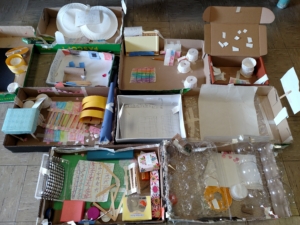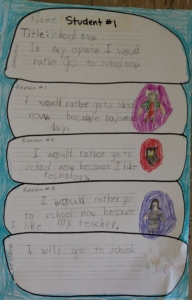Making in 1st Grade – The One-Room Schoolhouse

A student adds modern items to an old one-room schoolhouse.
At John Gill Elementary, a STEAM school in Redwood City, the first grade teacher, Ms. K., read an informational text to her 1st grade class on the theme of now and long ago. The text compared and contrasted devices people used in the 19th century with the devices we use today. When she finished reading, she asked students, “What items from our classroom would you want to take with you, if you could go back to an old, one-room schoolhouse?” The students were silent. “They just sat there on the carpet, staring at me,” she told me. “No one was talking.”
Ms. K. had an idea. She had been using making activities in her classroom this year, to help students explain their thinking around plot, scene descriptions, and characters. She went to the back of her room, grabbed some empty cardboard boxes and brought them back to the carpet. “I’m going to give each of you an empty box,” she told the class. “I want you to turn it into a one-room schoolhouse and make things that you want to take with you from today’s classroom back to your old schoolhouse.”
The students went back to their desks and started cutting up paper and small pieces of cardboard. They folded and colored and taped.
“I want to take some paper,” a boy said. He dropped little bits of folded paper into the box. “They had to write on chalkboards, but I want to write on paper.”
Another boy said, “I want to take some folders so I can keep my stuff in it.” He dropped a small piece of cardboard into his box.
Soon, students were making objects to represent iPads, backpacks, packets of colored markers, books, desks, and chairs. Ms. K. circulated and asked why they were dropping these objects in the schoolhouse.
“It was so interesting to see what they were making and to listen to their explanations,” she said. “They had no problems communicating their ideas when they were holding the item in their hands.” Once they had their ideas, Ms. K. helped her students transition from making to writing about their one-room schoolhouse. (See bottom of the page.)
Seymour Papert talked about why making helps students think when he was describing how his constructionist ideas differed from the earlier constructivist theories of his mentor, Piaget.
We understand ‘constructionism’ as including, but going beyond, what Piaget would call ‘constructivism.’ The word with the V expresses the theory that knowledge is built by the learner, not supplied by the teacher. The word with the N expresses the further idea that this happens especially felicitously when the learner is engaged in the construction of something external or at least shareable … a sand castle, a machine, a computer program, a book. This leads us to a model using a cycle of internalization of what is outside, (and) then externalization of what is inside and so on.
From: Papert, S. A. (1990). Constructionist learning. In Idit Harel (Ed.), Cambridge, MA: MIT Media Laboratory.

A collection of one-room schoolhouses.
The process of learning through sharing an object becomes a reiterative process. Students hear the story (internal), make and share objects (external), explain their thinking, receive feedback from peers and teachers, and then internalize their understanding to edit or create new external objects to share. At each stage, some form of knowledge building is taking place, but as Papert points out, more easily than processing the information internally and alone.
What I enjoyed in hearing Ms. K. describe this activity to me was how well she had internalized Papert’s ideas without ever knowing who Papert was. She has that natural instinct that many good teachers possess of knowing what helps her students learn. She had gleaned an understanding of constructionism by doing making activities aligned to content and seeing how her students responded. Papert would have been proud. Learning by doing was what he was all about.

